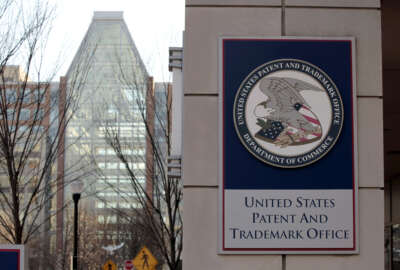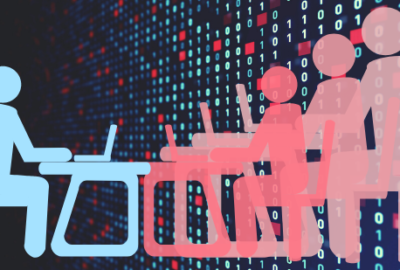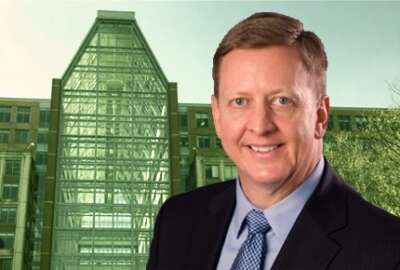

USPTO Director Andrei Iancu explained to how the telework experience helped in the pandemic when everyone was forced home. But first, Temin asked him about...
Best listening experience is on Chrome, Firefox or Safari. Subscribe to Federal Drive’s daily audio interviews on Apple Podcasts or PodcastOne.
The U.S. Patent and Trademark Office may not be on the front lines of medicine or research in the race to find a cure or vaccine for the coronavirus. But it has made several moves to help those who are. USPTO has also always been known for its high degree of telework. For years its patent examiners have worked from wherever they needed. In an interview with USPTO Director Andrei Iancu, he explained to Federal Drive with Tom Temin how the telework experience helped in the pandemic when everyone was forced home.
Interview transcript:
Tom Temin: Mr. Iancu, good to have you back.
Andrei Iancu: Great to be with you, Tom. Thanks for having me.
Tom Temin: And I guess a lot of this stems from the fact that pretty early on, that you decided or declared that the COVID-19 threat constitutes an extraordinary situation under patent law. Tell us more about that and then what are some of the moves that you made in procedure to fulfill that?
Andrei Iancu: Sure, as you will probably recall, earlier this year, the Congress – U.S. Congress passed the CARES Act, the president signed into law with a whole host of relief for Americans. One part of the CARES Act gave discretion to the USPTO director to take various actions if in fact the director believes that the pandemic necessitates such action. And indeed, within two days of the passage of the CARES Act, the USPTO immediately extended filing deadlines of a variety of types of documents by 30 days. And we extended the payment of fees deadlines by 30 days, giving patent and trademark applicants, and particularly small businesses and independent inventors, a needed lifeline at that time to keep very important inventions from being abandoned due to missed deadlines or the like. Since then, we have extended those deadlines several more times. And there is still an extension in place right now, for a subset of those deadlines.
Tom Temin: Because there is the electronic system to file papers that I guess was not available to those filing extension applications, only primary or the first-time applications. But now you have made the electronic system available to extensions. That seems like a pretty big change.
Andrei Iancu: Well, as the PTO we have, for the past several years, we have undertaken an effort to to move more and more of our filing systems online. And with this pandemic, we have effectively finished the job, so to speak, as of earlier this year, in light of the difficulties some of our applicants have had with getting to the post office or to our drop boxes. We’ve moved everything else online. So as of earlier this year, everything is online including, by the way, filing for planned patent applications. You might know that there are there’s such a thing as a planned patent. You know, in one way or another those types of applications were the, shall we say the stragglers, the last ones left that had to be filed manually. Now we are allowing those to be filed electronically as well as everything else.
Tom Temin: And did that take a lot of work on the IT staff to be able to expand those systems to the other formats or was it something that you could probably do anyway?
Andrei Iancu: You know, it took some work. And as I said, where we were in the process of going in that direction anyways, this just accelerated and our IT folks really stepped up to the plate and truly accelerated the remainder of these filings to come online. You know, the IT staff has done an absolutely remarkable job during this pandemic, not just making these changes that we just spoke about in terms of electronic filing, but more importantly – and I know you’ll get to this a bit later, Tom, I suspect – working with our 13,000 people who all of a sudden had to work full-time – telework full-time from home. And they really have done an amazing job of making sure that our IT infrastructure can withstand all the changes that we had to make rapidly during this pandemic.
Tom Temin: We’re speaking with Andrei Iancu, director of the U.S. Patent and Trademark Office. I do want to get to that but before we do just one more question on the external world and that is, has there been a spike or has there been an increase in or any kind of noticeable volume of patent applications related to the pandemic in some form, some new kind of respirator some new pill?
Andrei Iancu: Well, there have been a whole host of patent applications filed that are related to the pandemic. And also, by the way, not just patent applications but trademark applications as well. One of the relief measures, by the way that we have implemented is to allow for expedited examination of both patents and trademarks that are related to COVID-19. So, we know that a number of folks have filed such applications through this special expedited examination program. So that, alone, has been popular. And again, all those filings due to the way we set it up, have to be related to COVID-19.
Tom Temin: So that required that ability to expedite those particular classes of applications must have required some rejiggering of the workload and the schedule for the specific examiners, correct?
Andrei Iancu: Absolutely right. And the fact of the matter is, when we say that some application gets expedited, what that really means on the ground is that it jumps to the head of the line. You know, it effectively skips ahead of others in queue. And the examiner has to pick it up first. But we have put in place the required IT infrastructure to flag those and allow the examiners to see them at the top of of their cube. And by the way, Tom, the program is in my view, fantastic. So for what we said on the patent side, for example, for small and micro entities – so that’s small businesses, individual inventors and those who qualify – if they file through this program, we at the PTO promise to get their application, finish examination on their application within six months, as long as they also do their part and submit what they need to submit timely. That is a significant increase in the speed of examination as compared to regular application.
Tom Temin: Andrei Iancu is director of the U.S. Patent and Trademark Office. In the next hour, Iancu talks about the international intellectual property cooperation, telework, and how and if PTO will reopen its own Alexandria, Virginia, headquarters building.
— BREAK —
Tom Temin: USPTO has been working with some of the international colleagues, notably the Japan organization that is the equivalent of USPTO for Japan. Has there been an international cooperative type of effort related to pandemic, among the different patenting and trademarking organizations of other governments?
Andrei Iancu: Indeed, there have been, and since the pandemic, I have been in regular touch with my colleagues at other IP offices around the world. You mentioned the JPO, the Japan Patent Office. We have a long standing in very close collaboration with them. We’ve been in touch with them, I’ve been in touch with their head, for example, regularly during the pandemic. But beyond that as well, the European Patent Office, likewise, and also the Korean Patent Office in South Korea. In addition to all that, the world IP organization (WIPO), which is part of – it’s the IP agency within the UN system – WIPO has had regular calls regarding the how the various offices are handling the pandemic. So I and others at the PTO participate in those calls as well. The offices around the world have really stepped up and increased their collaboration during these times.
Tom Temin: Just out of curiosity, does Russia have an IP office and is that someone that we – do they have the same standards and kind of gestalt as the ones you normally deal with?
Andrei Iancu: Russia does indeed have an IP office. They don’t see as many applications as some of the bigger offices. But they do indeed have an office and they’re part of WIPO and the various treaties regarding IP around the world. You know Tom, almost every country has an IP office of some sort, including the smallest countries. Having said all that, almost 90% – not quite, but almost 90% of all IP rights in the world pass through five offices. We call them the IP five offices, that’s the United States, Japan, Europe, China and South Korea.
Tom Temin: Interesting. Well, let’s talk about the U.S. Patent and Trademark Office workforce. And for many years, the patent examiners have been the poster children of teleworking, and this goes back before now. It goes back probably 15 years. Did that experience help in the rest of the USPTO staff that is not examiners that had to suddenly telework starting in sometime in March?
Andrei Iancu: It helped indeed. So as you say, we have been at the forefront of the telework system in the federal government for quite some time now. And prior to the pandemic, more than 50% of our workforce teleworked full-time. An additional 37% of our workforce telework at least one day a week. So almost all in all, almost 90%, something like 88% of our workforce, telework at least one day a week. And this is prior to the pandemic. When we had to shut down in March, what we had to do is move 100% of the workforce to mandatory telework full-time five days a week. And our experience certainly helped. Having said that, it wasn’t easy for us either. You know, our IT infrastructure had to all of a sudden overnight handle something like 13,000 secure VPN connections. VPN, by the way, is a virtual private network. It’s the underlying internet connection to our campus every day. That was approximately a 75% increase of our daily average prior to the pandemic. And we did that overnight and seamlessly. Most important to us is our stakeholders and our applicants that come before us with our IP needs. And to them our mandatory telework for the past several months has been virtually transparent. Folks cannot really tell that the examiner is working from home, as opposed to their office. The one difference is that if they had to have an interaction with our staff, at this time at least they can no longer do it in person physically, they have to do it by telephone or video conference. But that was largely the case. People were doing that anyway prior to the pandemic. So this was a seamless transition. And it’s worked out very well. The speed, the quality, and the efficiency of the examination has been at least as good as prior to the pandemic.
Tom Temin: We’re speaking with Andrei Iancu, director of the U.S. Patent and Trademark Office. And PTO has one of the more impressive office setups in Alexandria, a beautiful big atrium and so forth. Do you plan to have people come back eventually?
Andrei Iancu: We do have beautiful offices and I remember fondly, Tom, our interview there on the premises about three years ago or so, I think. And it’s too bad that right now it’s virtually empty. We are now in Alexandria and in what we call phase one. So we’ve moved from the gating phase to phase one. What this means is that, while we’re still encouraging everybody to telework, those who need to come back for whatever reason, they can seek permission from their supervisors. And indeed, most days, I’m varying personnel and several other folks, but still, it’s pretty quiet, and we’re still closed for the public.
Tom Temin: At least the houseplants can get watered that are in the office, the office plants.
Andrei Iancu: Absolutely. The all-important office plant is is being watered and kept alive. But whether and when we go to the next phase will depend on several factors, which includes the local conditions on the ground. So we’re watching very carefully the stage of reopening in Alexandria. We also have our eye on the federal government norms. But most importantly, we will do whatever is necessary to ensure the safety of our employees. So we’re looking at this every day. And we’ll move to the next stage when conditions allow.
Tom Temin: Andrei Iancu is director of the U.S. Patent and Trademark Office. As always, thanks so much for joining me.
Andrei Iancu: Thank you, Tom. As always a pleasure.
Tom Temin: There’s much more to the interview. We’ll post it in its entirety at FederalNewsNetwork.com/FederalDrive. Subscribe to the Federal Drive on Apple Podcasts or Podcastone.
Copyright © 2025 Federal News Network. All rights reserved. This website is not intended for users located within the European Economic Area.
Tom Temin is host of the Federal Drive and has been providing insight on federal technology and management issues for more than 30 years.
Follow @tteminWFED



